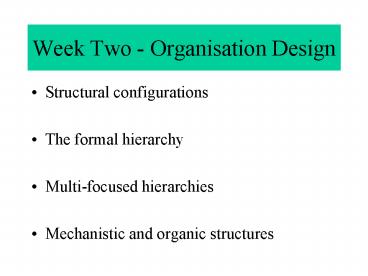Week Two Organisation Design PowerPoint PPT Presentation
1 / 23
Title: Week Two Organisation Design
1
Week Two - Organisation Design
- Structural configurations
- The formal hierarchy
- Multi-focused hierarchies
- Mechanistic and organic structures
2
Mintzberg' s organisational configurations
- Mintzberg argues that
- Structures exist to coordinate the activities of
different individuals and work processes. - The nature of the co-ordination changes with the
increasing size of the organisation.
3
Mintzberg' s organisational configurations
- Mintzberg' s idea
- the building blocks and co-coordinating
mechanisms required for any organisation are as
follows - Strategic apex
- Techno-structure
- Operating core
- Middle line
- Support staff
4
Mintzberg' s organisational configurations
5
Mintzberg' s organisational configurations
- The importance and relative size and mix of the
building blocks will vary depending on the
organisation - Mintzberg discusses 6 organisational
configurations all covering - The environment
- Type of work
- Complexity of tasks facing the organisation
6
Mintzberg' s organisational configurations
- Simple Structure
- Machine bureaucracy
- Professional bureaucracy
- Divisional form
- The adhocracy
- Missionary organisations
7
A Mass Production Process
8
The formal hierarchy
- Basic structural forms include
- Small business structure
- Functional structure
- Product and geographical structure
- Divisional structure
9
Small business structure
- Also known as the entrepreneurial structure
- Key advantage is simplicity
- Owner/manager can adjust employee tasks to the
latest opportunity - Owner/manager responsible for strategic and
operational management - Self-contained
- Self-controlled business unit
10
Functional structure
- Functional usually the next stage in the business
unit development - Strategic objectives decided at board level
- Planning is divided between
- Corporate level
- Functional level
11
Functional structure
12
Product Geographical structure
- As the number of products or geographic regions
grow functional design may not be appropriate - Product orientation is used
- Main functions are apportioned to relative
products - With each product group specialised personnel
will be attached.
13
Advantages of product divisionalisation
- Focus on product performance profitability
- Encourages growth and diversity
- The role of general manager encouraged.
- Product is generally preferred over geographic
due to complexity.
14
Possible Road Transport Enterprise
15
Divisional Structure
- When a functionally structured organisation grows
by diversification - Product structure is inappropriate
- Hence a divisional structure
- Strategic Business Unit (SBU)
16
Divisional Structure
17
Divisional Structure
- Difficulties here
- Corporate strategy becomes complex
- Increased divisional planning
- More operational planning at functional level
18
Holding (group) structure
- Radical form of divisionalisation
- Subsidiaries are legal entities
- Advantages
- A reduced central overhead
- Spreading of risk
- Easy to divest of subsidiaries.
19
Matrix Structure
- New complex structures
- Attention given to creation of
- Groupings
- Project teams
- Members of staff from different departments or
sections assigned to the team for the duration of
the project.
20
Matrix Structure
- The matrix structure
- Where two or more significant criteria for
success exist - Management of each criteria are equally important
- Managers have equal weight
- The objective is to capitalise of the areas of
expertise which can be stifled by the normal
hierarchy.
21
Matrix Structure
- Adv
- Retains functional economies and product
co-ordination - Open communications and flexible goals
- Improved motivation
- People working in teams
- Specialists broadening outlook
- Encourages competition within the organisation
22
Matrix Structure
- Disadvantages
- Higher administrative costs
- Conflict between functional and product managers
- Threat to occupational activity
- Reporting to more than one superior
- Expectations not as clear i.e. everything is
important, pay equal attention to everything!!
23
Organic and mechanistic structures
- Burns Stalker (1961)
- Distinguished between organic and mechanistic
structures - The beginning of administrative wisdom is the
awareness that there is no one best way of
designing a management system

